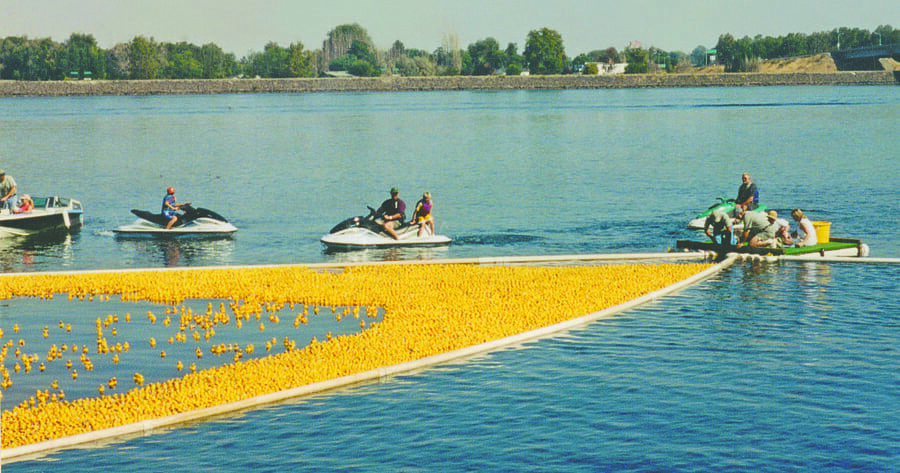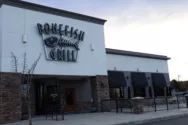
Home » Tri-City Rotary clubs raise almost $3M for charities in 30 years
Tri-City Rotary clubs raise almost $3M for charities in 30 years

August 14, 2018
By C. Mark Smith
This year marks the 30th anniversary of the Mid-Columbia Duck Race and it is clear the annual fundraiser for six Tri-City Rotary clubs has been an unqualified success.
The clubs estimate that over the past 30 years, almost $3 million has been donated by the local Rotary clubs to more than 100 local charitable organizations, various scholarship programs and projects that improve the quality of life of the Tri-City community.
Over the past three years, the race has generated an average of $190,000 a year, while the net proceeds received by the six clubs averaged more than $111,000.
The number of ducks in the race has grown to more than 40,000 each year. More than 40 local sponsors recognize the value of being associated with the race and regularly donate prizes.
Toyota of Tri-Cities has provided the top prize, a new Toyota, for the past 14 years.
“The local Rotarians give so much to our community, this donation is just one way we can help them fulfill their mission and ensure the Tri-Cities area remains one of the best places around to live, work, and play,” said Carmen Marquart, the car dealer’s marketing manager.
This year’s race is Oct. 6 at Columbia Park in Kennewick.
The idea for the duck races emerged in 1989. Dick Weaver, the newly elected president of the Columbia Center Rotary Club in Kennewick, had just returned from the annual president-elect training conference where he’d learned about a new fundraising method called a duck race.
Dean Hoffman, president and CEO of Columbia Industries, a Kennewick-based nonprofit providing vocational training for people with disabilities, also was a member of Weaver’s club. He found out about the duck race independently and thought it could be a great source of income for their organization.
Hoffman and Weaver presented their idea to the club’s board, which enthusiastically endorsed the idea, but felt the logistics and administration of a project of that scale might be too much for a single club. Weaver quickly recruited three other local Rotary clubs to help.
The concept of the duck race was simple. Thousands of small plastic ducks would be rented from a company in Arizona. Rotary club members would sell tickets to their friends and associates for $5 each. The corresponding number of each ticket would be attached to a plastic duck, which was then officially entered in the race. The ducks would be dumped into the Columbia River, float down a designated course, and reach the finish line, where they would be collected in the order of their arrival. The holders of the winning tickets would receive prizes purchased by the club or donated by local corporate sponsors.
The participating clubs would divide the net proceeds based on the number of tickets sold. Each club would donate the proceeds to their favorite local charities and nonprofit or invest in worthwhile community projects, student scholarships or philanthropy.
CI would provide services such as marketing and administrative support, and their employees would get helpful work experience. In return, CI would receive 35 percent of the net profit received by each of the clubs.
While the concept of the race was simple, the organization and logistics were not. The time of the race was dictated by when the ducks would be available from the rental company, which was in early October. That left only a few months to organize and launch the event, and no one was sure they could pull it off.
In the rush to put on that first race, no one had thought to contact the Gambling Commission. When the state agency found out about it, it determined the race was a lottery, and state law required a separate ticket be sold for each duck. The next year’s tickets had to be redesigned, and getting a gambling license became an annual expense.
In its first year, the race became the largest duck race in the western United States with 28,000 rubber ducks rented, and almost that number of tickets sold, raising almost $140,000 and generating a net profit of $77,000.
Based on this success, more local Rotary clubs adopted the duck race as their primary fundraiser. For the second race in 1989, 30,000 ducks were rented, of which almost 25,000 were sold. Before long, local car dealers and other merchants were contacting the organizers to donate prizes and take advantage of the publicity.
In the third year of the race, Dan Boyd, president of the Pasco-Kennewick Rotary Club, came up with the idea of recruiting and recognizing corporate sponsors called Quacker-Backers, who might buy 25 ducks, or 50 tickets at a time. It was easier to sell 25 duck tickets to one buyer than to sell 25 individual tickets.
The race was clearly a matter of trial and error in those first years.
“When 40,000 plastic ducks are dumped into the river at one time, they sink under the surface and then blossom up like an atomic bomb expanding out in all directions,” McLean said. “We didn’t have any floating pipe to mark the outer boundary of the course, and many of the ducks got caught by the river’s current and off they went. We used jet boats provided by a local company to try to force them back onto the course, but that was only partially successful.”
They watched helplessly as most of the ducks rode the waves down the river. The next year, someone returned a duck they had found floating near McNary Dam, 50 miles downstream in Oregon.
By 1998, the 10th year of the event, the race had grown into a major community event. By then, corporate sponsors were accounting for $40,000 a year in ticket sales, and the event had raised more than $1 million and benefited more than 60 charities and local scholarship programs.
The biggest single expense of the race, renting the ducks at a cost of 53 cents per duck, was covered by a donation from a local bank.
Large inflatable ducks added to the adventure. In the windy Tri-Cities, it was imperative to anchor the 10-foot tall ducks so they wouldn’t blow away. That was not the only danger. In the first year of the race, a $3,000 inflatable duck was stolen from the front of a local sporting store. Rotarians filed a stolen duck report with the police, and the theft was covered by all the local TV stations. The duck was returned by the “duck-nappers” two days later, minus the air compressor used to inflate it.
McLean remembers another occasion, perhaps seven or eight years into the race, when he and another Rotarian took the inflatable duck to a car dealership in Pasco. “When it got nearly blown up, the seam along the back of the duck’s neck gave way, and all of the air escaped in a big whoosh. We tried to think of something that we could use to plug the foot-long hole,” he said.
Off they went to a nearby big box store in search of a solution. “I came up with the idea of trying to seal it up with a package of washcloths held by large safety pins. I got into the duck and crawled up to the hole and then stretched the washcloths over the hole and pinned them securely to the duck with the safety pins. We turned the air compressor back on, and the duck was rising up to its full height when we heard this zinging sound as the safety pins gave way and were flying off the head of the duck like shrapnel. We returned the duck to the rental company,” he said.
By the 20th anniversary of the race in 2008, a record 40,501 duck tickets were sold, generating more than $200,000. More than $175,000 was distributed by the six participating Rotary clubs to more than 80 charities and other community endeavors.
Before long, some members of the Tri-Cities Sunrise Rotary Club were selling as many as 2,000 tickets a year to corporate Quacker-Backer sponsors, and the club accounted for 40 percent of all the duck tickets sold. Some individual Rotary members, like Jack Zinn and Jon Putz of the Richland club, sold more than a 1,000 duck tickets each year—most of them one ticket at a time.
After 20 years, the race had outgrown its ad hoc, volunteer organizational structure.
“It dawned on me and others at the same time that, ‘Hey, after 20 years, this thing isn’t going away. We need to get organized,’ ” said Mike Tuohy, a retired hospital administrator, president of the Columbia Center Rotary Club who was his club’s representative to the organizing committee.
They incorporated, drew up organizational documents that had to be approved by all six clubs, and negotiated with the Boy Scouts to provide much of the administrative record-keeping and reporting that had been parceled out to volunteers before. They reviewed and renegotiated contracts and generally put the race on a sound administrative footing for future years.
McLean believes that the greatest benefit of the duck race has been how it has brought the local Rotary clubs closer together.
“It was the ideal fundraiser because it challenged us from the very beginning. And the memories of the race—the ducks bobbing down the course, the small child being hugged by Lucky Ducky, the comradery of working together on a shared project—remain with those who have experienced them forever. What better example of Rotary’s motto, ‘Service above Self,’ ” he said.
C. Mark Smith is a Richland Rotary Club member. He is the author of four books and many magazine articles dealing with history and biography.
Local News
KEYWORDS august 2018





